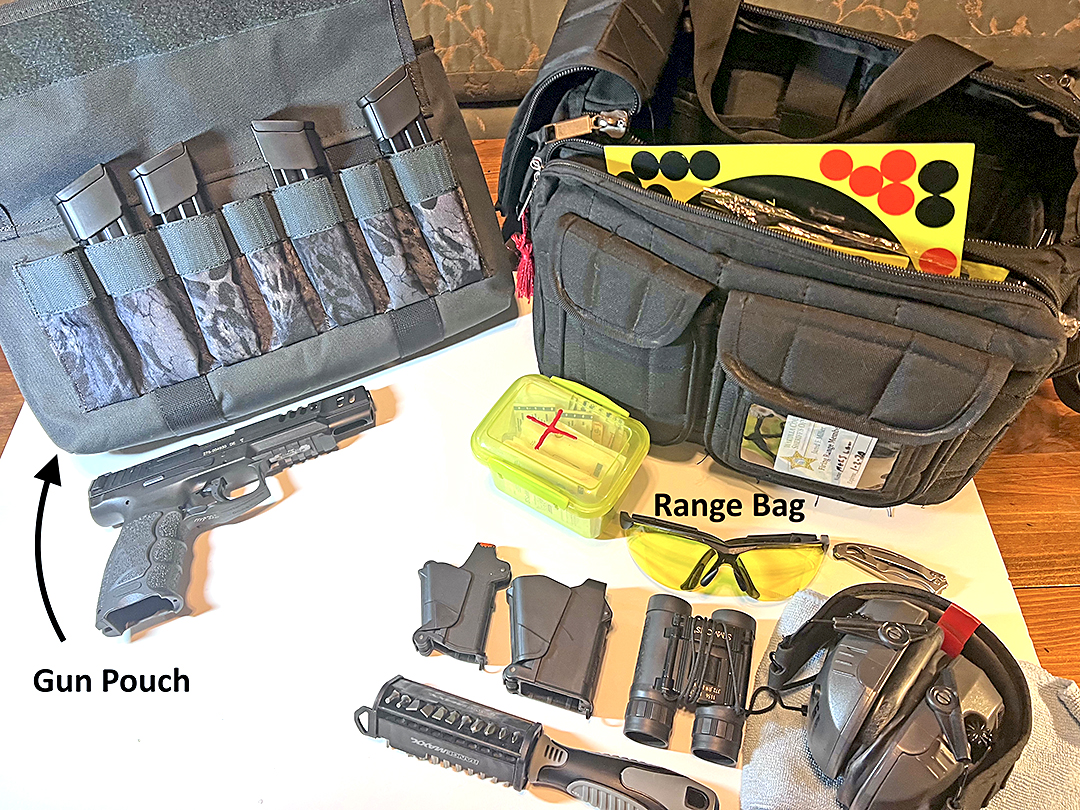PART 6: YOUR RANGE BAG

By MARJ LAW

Many handguns come in nifty plastic boxes. Others come in cardboard boxes. Did you notice that while there’s room for the magazine(s), your “eyes” and “ears” will not fit in that little box?
So how do you bring your gun to the range? Somehow, you know that carting your glasses and ear muffs in a paper bag won’t impress anyone.
Most people like a small gun pouch for their gun(s) and magazines, and a larger range bag for everything else.
“I put ammunition in the smaller gun pouch,” Joe says, just so I know he hasn’t forgotten to mention something so necessary. “There are usually pockets on one side of the smaller pouch for magazines, and larger pockets for boxes of ammo on the other side.”
Let’s talk about the range bags.
Some people have range bags that are made of hard plastic, but more seem to prefer good-sized heavy-duty fabric bags with many pockets. I don’t like the hard plastic ones. They bump against my legs when I haul them out of the trunk of my car and they seem oversized. The fabric bags are light and have room for all sorts of things I like to carry.
So, since you must have “eyes” and “ears” at the Wakulla County Sheriff’s Office range, I ask Joe what he thinks are the next most important objects to put in his big range bag.
“Have we thought about targets and ammunition?” I ask.
“Yes, targets and a stapler and/or tape to put up those targets.”
“Wouldn’t a newbie prefer the sticky Shoot-N-See type target? Then you don’t have to remember the stapler, staples and tape.”
“A screwdriver, jackknife and Allen keys are good in the bag. Also, a spotting scope or small binoculars,” he adds.
“Why are screwdrivers, jackknives and Allen keys good for Newbie?” I wonder. “After all, isn’t that a bit much for a newbie?”
“They can adjust sights, or other parts that come loose,” he says. “If you have a stovepipe, your jackknife can flick it out of the ejection port.”
“I didn’t bring those when I started out,” I maintain.
“Well, I did,” he replies smugly. “And I used them to help you with your guns.”
Yes, I do have to concede that one.
“So, what next would you tell Newbie to bring in the big bag?”
“The spotting scope or binoculars. And gun cleaning supplies.”
“Joe, they prefer it at the WCSO range that you don’t clean your guns at the shooting bench.”
“Well, the spotting scope is good or those small cheap binoculars like you have are useful, too.”
“Yes, even targets that change color when the bullet hits are easier to see when you’ve got baby “nocks,” I agree. “Spotting scopes are more useful on the long gun range or for longer distances than we usually shoot in the handgun range.”
Joe and I do have different priorities for our big range bags.
I really like to keep a MagLula in the case. Actually, I like two MagLulas. One is for single-stack magazines and one is for double-stack magazines.
“Master Chief Gunner’s Mate Super Strong Thumbs would certainly disagree with you,” he says sternly. “The only way to load a magazine is with your thumbs.”
“Well, you have big and strong hands,” I mimic sounding like a timid girl. “My hands are small and I’m not afraid of using a little assistance!”
“Add in a first aid kit,” he suggests. “Not to scare Newbie, but you might cut your finger accidentally.”
“And hole patches,” he adds. “You can save money by covering bullet holes in your target. This allows you to use fewer targets, especially since you like those expensive sticky ones.”
“Sue me. I like the bright colors. And it really shows up when I hit a bull’s-eye.” I’m not giving up my pretty targets.
“If you’re new to handguns, a front and rear shooting rest can help. This way, you can steady your gun to find if your sights are aligned properly, or if you’ve just had too much coffee in the morning and your hands are shaking.”
“Or if you’re getting older and your hands shake anyway,” I clarify. (He’s not so happy with that thought.)
Tiny flashlights are handy to have in your case. Is a bullet lodged in the barrel? Aim the light down to the chamber to see if it’s there. You always want a clear barrel. These lights are inexpensive and bright.
A microfiber cloth is very useful. Dirty eyeglasses? Microfiber. Spots on your red dot sight? Microfiber. Wet shooting bench? Well, you get the point. These microfiber cloths are good for many things. I halve one and sew 2 seams. This creates a good case for your shooting glasses.
Paper and a pen are good in a range bag. Met new people at the range and wish to record their information? Want to make notes on the way your gun is shooting? Yes, you can do this on most cell phones, but some of us still write the old-fashioned way.
I think more gals than guys carry hand wipes. They’re good for cleaning small cuts. They’re good for getting the lead off your hands after shooting.
Most of us aren’t bothered by the carpenter bees at the WCSO range. We ignore them as they don’t seem to be biters. But sometimes those tiny gnats swarm, so we put bug spray in our bags.
I guess the guys don’t add lip gloss, nailfile or a hair scrunchy, but they end up in my case.
Joe remembers to suggest a bottle of water to stay hydrated.
In the hot and muggy Florida summer, we gals wearing the ear muff kind of hearing protection get sweat in our hair. This makes for a bad “do.” So, a comb helps some. Doesn’t get the sweat out, but might make us a little more presentable as we get ready to do lunch.
Lunch after shooting is an important part of our day. It’s social, and gives us some time to share information about what we’ve learned from our handguns and ammunition.
Mostly, though, we’ve become friends. That’s most important.
So. What’s in your range bag?
Marj Law is the former director of Keep Wakulla County Beautiful who has become an avid shooter in retirement.
